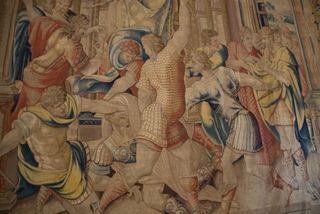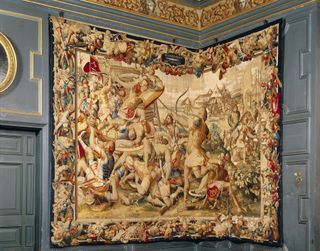A tapestry convert
I used to be the kind of person who gave large Renaissance or Baroque tapestries a miss. I would spend forever looking at grimy paintings, but tapestries -- with dull figures, indistinguishably classical, biblical or more recent historical, draped over the walls of usually ill-lit corridors -- somehow never made me stop.
It is only since doing my '12 Caesars' project looking at images of emperors in Renaissance and later art that I have come to see the wonder of tapestries, to understand that the interwoven silver and gold thread, in amongst bright colours now sadly -- and differentially -- faded, on vast 'canvases', shining out against the flickering lights of the candles must have made for some of the most spectacular displays on interior decor in the Renaissace and early-modern worlds. And they were also where the money of the super-rich went. When the property of Charles I was valued after his exacution, the priciest (movable) items of all were two series of tapestries: one of the story of Abraham, the other of the story of Caesar and Pompey.
None of the Caesar and Pompey series from the royal collection still survives (it's a mystery what happened to it), but one similar piece of the same date (1540s) still survives in the Vatican: "The assassination of Caesar" (above).
This series was commissioned, or bought on spec (though that seems implausible), by Henry VIII for Hampton Court, and has been the subject of an enormous amount of detective work, by Tom Campbell, director of the Met, and others. It is a wonderfully enterprising bit of tapestry archaeology, trying to go from a whole series of later weavings, up to the mid seventeenth century, back to what Henry VIII had on his own walls.
Some of the most interesting of those later weavings have ended up in Powis Castle. They include the battle scene above, which is known in several versions. The headings in the different tapestries call it "Caesar making an attack" (as here at Powis), "Caesar fighting a giant" or (to judge from the description of a lost work) "Caesar taking the town of Gomphi". My view is that, whatever the woven captions, the original designer of the scene had a very different incident in mind, from Lucan's Pharsalia. I'll tell you what I think soon. But I just wondered if the scene looked as obvious to anyone else who knows Lucan as it does to me.
If so we could make a bit of a difference to the history of tapestry!
Mary Beard's Blog
- Mary Beard's profile
- 4114 followers





